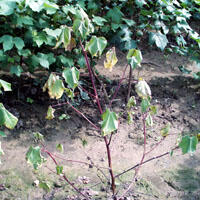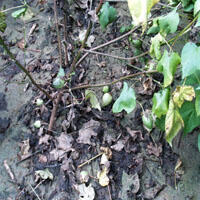Cotton
Bronze Wilt

During the day the leaves of these affected plants will be very hot to the touch. This is due to an apparent shut down of the vascular system and a reduction in transpiration and evaporative cooling. The symptoms begin as a few scattered plants in the field and then will spread to more plants until the entire field may be effected. When the stems are cut, and the vascular tissue is examined, there will be no visual discoloration or other evidence of blockage like that associated with Verticillium Wilt. This problem may lead to, and is generally associated with, leaf and boll shed.

It has been speculated that low levels of potash could have caused the problem. Fields that I visited in 1998 may have shown some possible symptoms of potash deficiency. However, potash deficiency did not cause the problems described here. In fact, the wilt problems associated with these fields led to the symptoms of potash deficiency.
This problem (Bronze Wilt) was first observed on a large scale in 1995. The problem was very severe in Louisiana in 1995 and Mississippi had problems in several fields. However, there were only a few fields in Mississippi that had a significant yield reduction that year, unlike Louisiana.

It is not known what causes Bronze Wilt. It is probably associated with a variety environment stress interaction. At present, there is reason to believe that it is primarily associated with varieties that have TAMCOT-SP37 in their breeding background. In 1995, it was seen in the 1200 series Hartz cottons and Stoneville 132. In 1998, it was found in the Paymaster 1200 series (1220-1215) and Stoneville 373 The Paymaster varieties were acquired form Hartz.
When a field gets this problem, there is basically no cure. If any of the varieties known to show the symptoms are planted, they must never be allowed to stress. It appears that the incidence of this problem is worse when the plants have a boll load and are put under a hot-dry stress or just a heat stress. Perhaps low potash can influence this as well. There is no cure. Variety selection is the best means of prevention.
Cotton
- Application timing
- Boron Deficiency
- Bronze Wilt
- Can you tell me about sprayer calibration?
- Commonly used harvest-aid materials
- Defoliation General Discussion
- Hail Damage
- Nitrogen
- Nitrogen Deficiency
- PIX Use
- Potassium
- Potassium Deficiency
- Potassium Sources
- Questions about cotton following a hurricane
- Sand Blasting Injury
- Sulphur Deficiency
- What are Mississippi's freeze dates?
- What final live plant population should I target?
- What is the recommended seeding rate for cotton?
- What percentage of my crop should I plant in B.t.?
- What should be the soil temperature at planting time?
- What should I do about hail damaged cotton stands?
- What variety, or varieties, should I plant?
- When should I consider replanting cotton?
- Will foliar feeding seedling cotton increase yield?